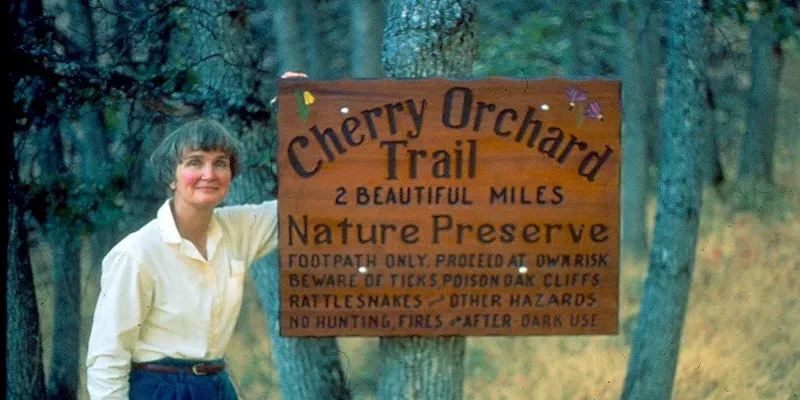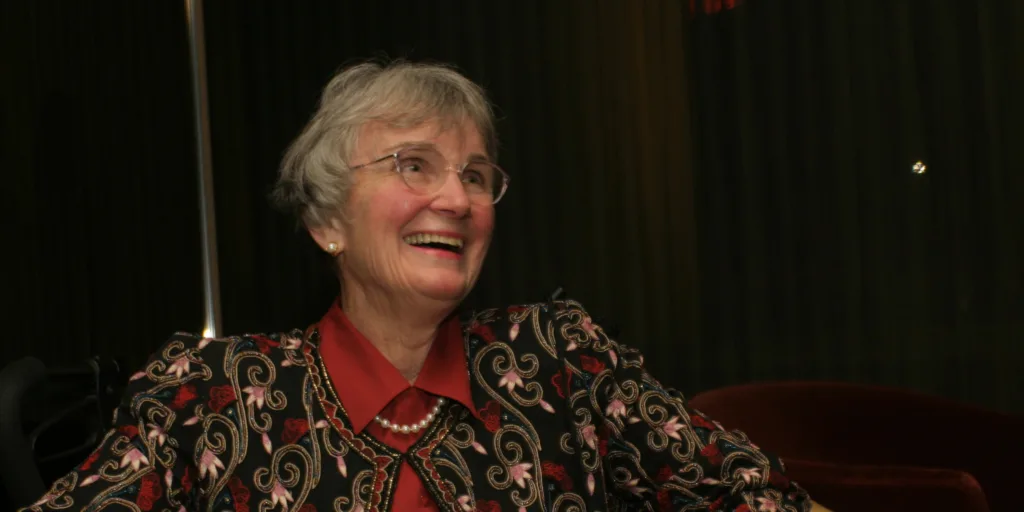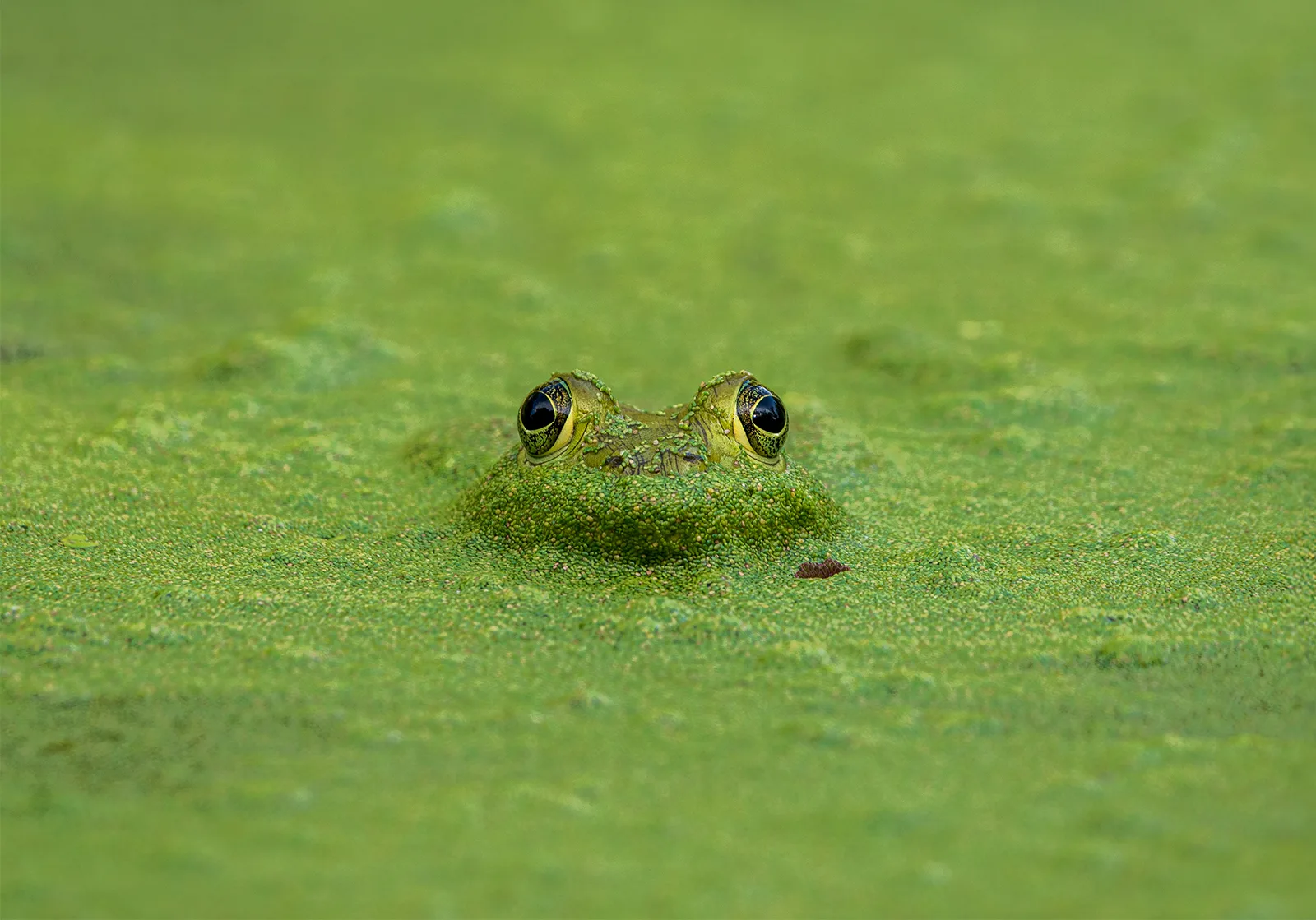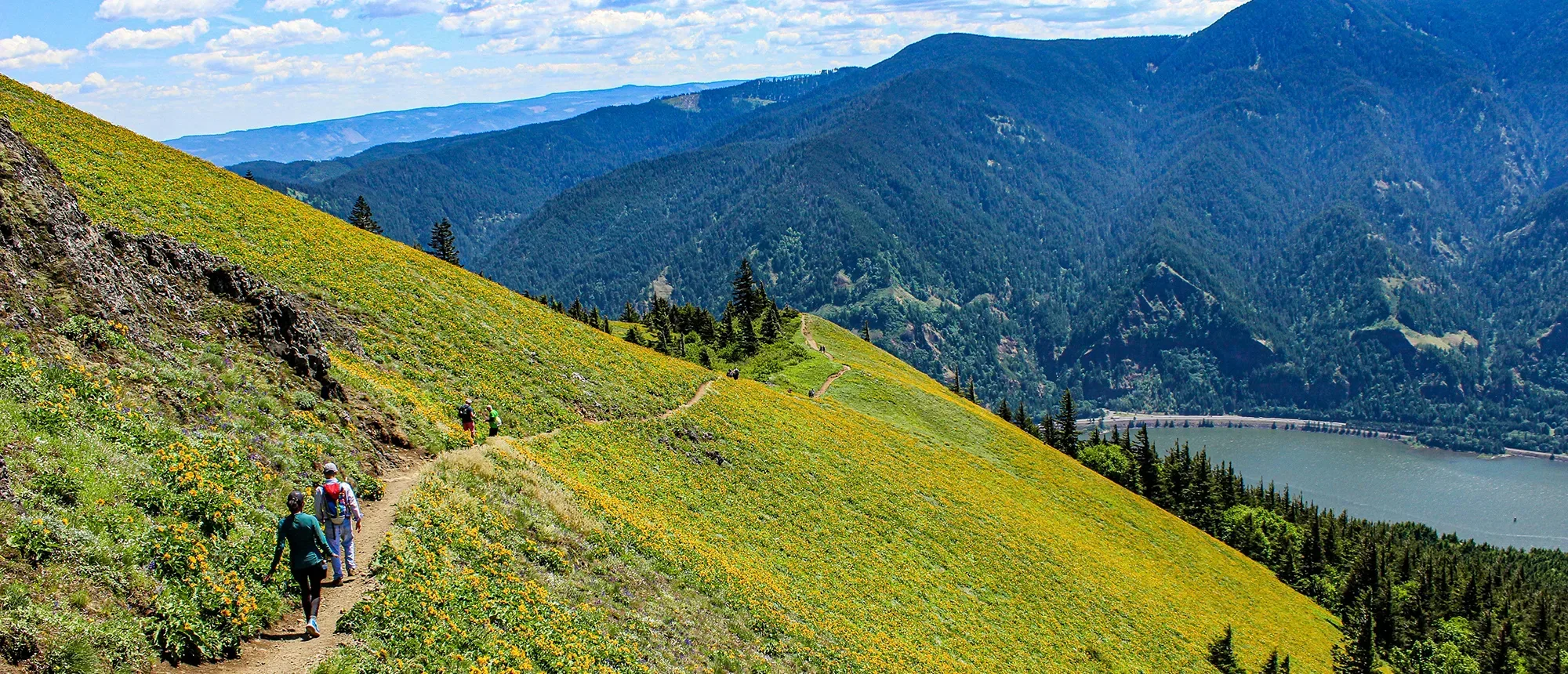Friends Founder Nancy Russell was a passionate environmental activist who fought one of the most fiercely contested conservation battles of the 1980s. Her work led to the creation of the Columbia River Gorge National Scenic Area.
Facing east from the Cape Horn lookout near the western end of the Columbia Gorge, you can see one of our planet’s most spectacular landscapes extend for miles. A marvel of millions of years of geological sculpture, the canyon slices through the Cascades, while basalt cliffs stretch toward the sky and deserts and forests sprawl along the great river. Here, the land is full of rich and still-changing human history, and vibrant communities are home to more than 75,000 people.
All of this would look very different if it weren’t for one woman: Nancy Russell. With vision and tenacity, she overcame daunting opposition and built a groundswell of support for conserving this area more than four decades ago. Thanks to her phenomenal effort and the movement she built, today 292,000 acres are protected as the Columbia River Gorge National Scenic Area.
Natural Leadership
“I don’t think any one person did as much as Nancy to save one place in the Pacific Northwest,” said Friends of the Columbia Gorge Executive Director Kevin Gorman. “She was the right person at the right time. Other people helped carry the effort, but she persisted for years.”
A Portland native, Nancy fell in love with nature during her childhood in the 1930s, when she lived on her grandmother’s Yamhill County farm. She moved back to Portland as an adolescent, attended college on a scholarship, and became a hiker and gardener. For years, she took frequent treks in the Gorge, developing a deep appreciation for its native plants and wildflowers.
Nancy was also a seven-time amateur tennis champion. Competitive and relentlessly optimistic, she enjoyed surprising people who didn’t take her seriously because she was a woman. She loved beating the competition, which often included men—who didn’t intimidate her on or off the court.
By the late 1970s, Nancy and her husband Bruce had raised four children, and she was an active Portland Garden Club member. Her knowledge of the Gorge had become encyclopedic, and her deep community roots, diplomatic skills, and drive to win caught the eye of an advocate deeply concerned about the Gorge.

Imperiled Gorge
The Gorge had already faced threats for more than a century, from Oregon settlers who displaced Native tribes to timber and development interests. But in the late 1970s, a planned I-205 bridge promised to bring large-scale Portland and Vancouver-area sprawl to the Gorge. At the same time, the National Park Service was considering extending federal protections to the Gorge thanks to the leadership of the Columbia Gorge Coalition—a Gorge-based effort co-founded by Charles Otis “Chuck” Williams. But the prospects for the Park Service proposal were uncertain.
Portland-area architect John Yeon, son of the roadmaster of the Historic Columbia River Highway, recognized the problem and the opportunity. But the Gorge needed new energy to spearhead a protection effort. On a summer evening in 1979, Nancy and Bruce joined John at The Shire, his property across from Multnomah Falls, and John asked her to be that leader. The movement to save the Gorge began.
The work kicked off at a July 1980 picnic at the Shire, when Nancy and John formed a 38-member Committee to Save the Gorge. The group faced an overwhelming task of building support for bi-state Gorge protection. To make things even more daunting, the National Park Service lost clout under the Reagan Administration with notoriously anti-environmental Secretary of the Interior James Watt at the helm of national park decisions. Instead, local advocacy efforts shifted to establishing a National Scenic Area for the Gorge under the U.S. Forest Service.
At a November 1980 Portland Garden Club gathering, Multnomah County Executive Don Clark named four people, including Nancy, to an organization to promote this mission. Though the name wasn’t established until a few months later, this meeting was the beginning of Friends of the Columbia Gorge.

Grassroots Movement
John Yeon and Don Clark recruited Nancy—who had no political experience—based on her presence, energy, and love and knowledge of the Gorge. She had to assemble people and learn on the fly how to run a political advocacy plan in a nearly insurmountable political climate. She was up against more than 70 years of regional timber industry activity, local property rights groups, unsympathetic state and local politicians in five of the six Gorge counties, and the Reagan administration.
Nancy began with people she knew and broadened her base, creating a Friends slide show and delivering presentations around Oregon and Washington about the Gorge and the importance of its protection. She led Friends hikes, getting people into the Gorge so they could experience it firsthand. Just for the hikes alone, she brought together organizations, raised money, purchased insurance, trained hiking leaders, scouted hikes beforehand with leaders, printed brochures, and arranged post-hike music and speakers.
“That’s symbolic of what she did for the entire movement,” said Bowen Blair, former Friends board member, Columbia River Gorge Commissioner, and author of the forthcoming book Force of Nature: Nancy Russell’s Fight to Save the Columbia River Gorge. “She had incredible stamina for creating the National Scenic Area, and it was a labor of love.”
Nancy’s multi-pronged campaign at Friends built a snowballing grassroots effort, including support from conservationists and business leaders. Backers also included a former Washington governor and city and county commissioners from both sides of the river. These people and others gave Nancy and her allies (including Bowen as Friends’ second executive director) entry points in their lobbying at home and in Washington, D.C., ultimately helping her recruit U.S. Senator Mark O. Hatfield in Oregon. Sen. Hatfield would prove to be a crucial advocate for protection of the Gorge—using his vast political influence and influence with leaders on both sides of the aisles both at home in the Northwest and in Congress.

Building Inroads
But Nancy’s advocacy came with a cost. The community appropriately viewed her as the leader of the movement to protect the Gorge, and entrenched interests such as property rights groups, distrustful Gorge residents, and the timber industry began working to knock her down with a steady drumbeat of anti-Nancy Russell publicity.
She faced threatening phone calls. Slashed tires. Opposition ads. Bumper stickers that read “Save the Gorge from Nancy Russell.” And even death threats.
But Nancy persisted. “Any experienced politician would’ve found this difficult, and it was even tougher for Nancy, since she didn’t have that background,” said Bowen. “While she took death threats seriously, the challenges didn’t dissuade her—they made her double down.”
She believed that a large, engaged membership was essential for the Gorge’s protection, so she did it all: worked in the Friends office, spoke with reporters and groups, and took donors and elected representatives on Gorge tours every day, then gave multimedia slideshows after cooking dinner for her family every night.
To the point and diplomatic, she could persuade people from all backgrounds, “but she never backed down,” added Bowen. “She knew exactly what she wanted and how she could get there. If someone argued with her, she’d make her point perfectly and not take any threats personally but was prepared and clear—whether she was facing an opposition member or U.S. senator.”
Nancy used her strong personality and diplomacy to build inroads. “The appeal and love for the Gorge crossed so many boundaries, from local community members to industry titans,” said Michael Lang, Friends’ conservation director. “And Nancy was an incredible, inspiring leader who had a broad vision.”

One Acre at a Time
At the same time, Nancy and Bruce made a crucial no-interest loan in 1987 to the Trust for Public Land to help buy the Rim View lots at the top of Cape Horn for later conveyance to the U.S. Forest Service, a conservation effort that was crucial in creating the modern Cape Horn trail system. She and her husband also began purchasing land in the eastern and central Gorge. Thanks to their personal financial resources and frugal lifestyle, she was able to use their own money, essentially becoming a one-woman land trust for lands that were then sold or donated to the Forest Service for public use.
“There aren’t many people who would keep buying run-down places, fixing them up, selling to the Forest Service at a loss, then doing it again,” said Kevin.
“She understood that government moves slowly, and that private community members can move more quickly to purchase and protect the land,” said Michael. “She had the vision and willingness to put herself in financial risk because the mission was so important.”
Her purchases ultimately totaled 30 properties, including the Lyle Cherry Orchard in the Eastern Gorge. And in 2021, our land trust’s 36-acre acquisition on the Cape Horn bluff completed an agreement Nancy made with the landowners in 2005, expanding access to the area that captured Nancy’s heart and galvanized her conservation efforts throughout the entire Gorge. Her namesake overlook perches above the river, offering panoramic Gorge vistas.
Landmark Advancement
For years, Nancy and her allies continued to overcome opposition and marshal support for the passage of the National Scenic Area Act. She flew to Washington several times and met with lawmakers, including Vice President George H.W. Bush. And then, on November 17, 1986, six years from the formation of the group that became Friends, President Ronald Reagan was poised to sign the Columbia River Gorge National Scenic Area Act—and called Sen. Hatfield, threatening to veto.
But Nancy had cultivated Sen. Hatfield as a champion. He didn’t retreat from the political showdown, emphasizing that some of Reagan’s top priorities were in his Appropriations Committee and ultimately convincing the president to sign.
In the end, the Columbia River Gorge National Scenic Area Act protected 292,000 acres and was one of only a few conservation bills that Reagan signed into law.
Monumental Legacy
“Nancy changed everything,” said Bowen. “She was by no means the only person involved in the effort, but if she hadn’t led the fight, the Gorge wouldn’t have been protected.”
Recognizing that an environmental law’s passage is just the beginning, Nancy continued to build Friends as a strong advocacy organization with policy and legal chops. And the organization continued to grow, push for National Scenic Area Act implementation, and safeguard Gorge land through strategic purchases. Friends’ land trust was created in 2005 to continue and build upon the many personal land acquisitions made by Nancy and Bruce over the decades.
“Nancy always wanted to keep working to make the Scenic Area Act live up to its potential,” said Kevin. “She fought for the Gorge even after its passage.”

Friends Today
Nancy passed away from ALS in 2008. She continued visiting the Gorge until the end of her life, and in her final years, she started seeing that a growing number of people appreciated her tireless work.
Her organization, Friends of the Columbia Gorge, which began with a few motivated people, now includes more than 6,000 members and a level of support in Gorge counties that would’ve been unthinkable in the far more contentious 1980s, as well as its own land trust and robust conservation advocacy, legal, hiking, and youth education programs. And there is still more work to do.
“Nancy was the first one to point out that we cannot say that the Gorge is saved,” said Bowen. “It still faces pressures, and challenges such as climate change are still taking shape.”
But without the National Scenic Area, much of the Gorge wouldn’t have survived. The movement she created, lawsuits, and land acquisition stopped development, and the Gorge remains protected and accessible. Yet her legacy is even larger, and her tenacity remains an inspiration for advocates today.
“Nancy was successful because she had the courage to advocate for the Gorge’s protection,” said Michael. “That’s something she taught me: the courage to be an advocate.”
Latest News

Invasive Predator: Inside the Race to Control the Deadliest Threat to Gorge Turtles

Native Prey: Inside a 30-Year Conservation Partnership to Save a Species


